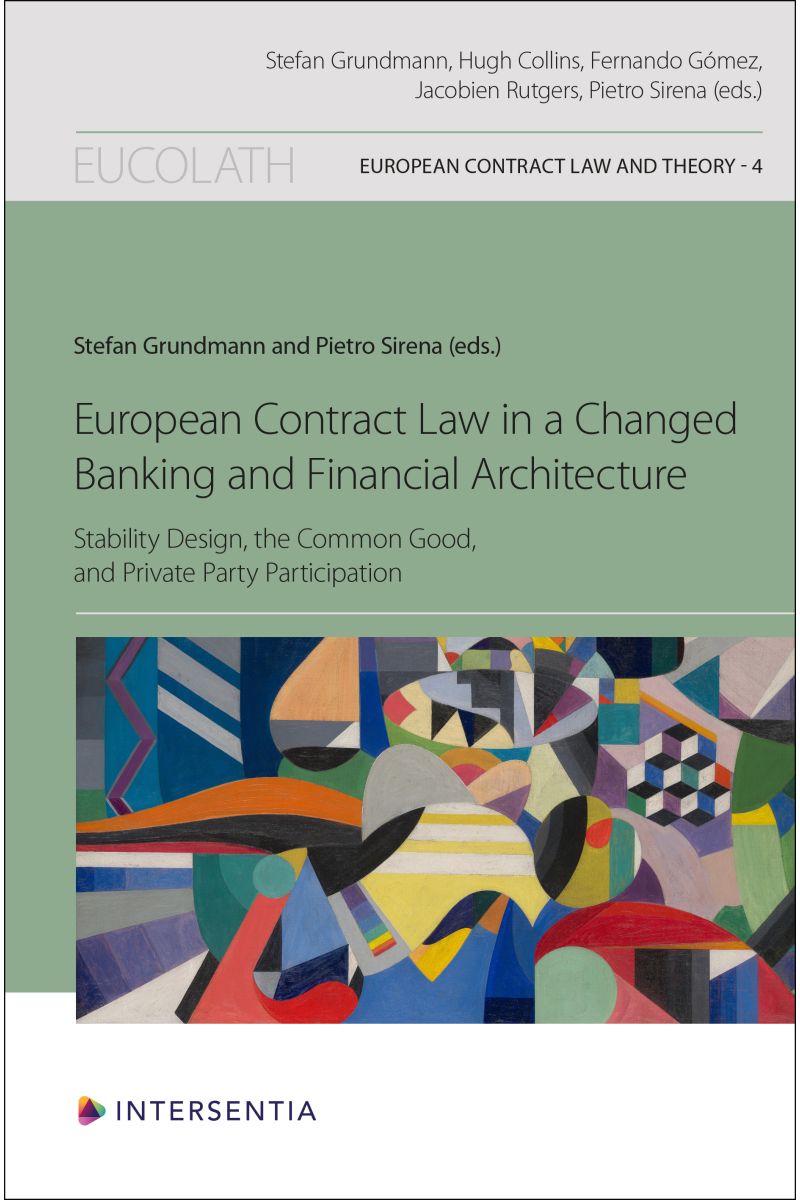 maestro
mastercard
visa
maestro
mastercard
visa

European Contract Law in a Changed Banking and Financial Architecture
Stability Design, the Common Good, and Private Party Participation

The European Banking Union forms the answer of the EU to the global financial crisis, strongly increasing own funds basis for more robust credit institutions, installing a recovery and resolution regime with strong planning and preventive measures and opting for the supervisory with the broadest reach, the European Central Bank. The first part of the book – after the design of the overall architecture and a clarification of the main policy lines and theoretical underpinnings – describes the main features of this regime. It does so in particular for recovery tools and their conceptual novelty, focusing on private claims within the regime, namely within deposit guarantee schemes and for liability of supervisory authorities. The main question asked in the volume is, however, in what respects this new regime changed European Contract Law. The answer is two-fold, and this is the focus of the still more extensive second part. The first answer is that the main thrust – stability first and no socialization of costs and privatization of gains – constitutes a novel approach, a clear dedication to the prevalence of the public good. This is a thrust, which – with corporate social responsibility, responsibility driven lending and similar – will become the main development in the 2010s and 2020s. One can speak of a green-box approach that establishes clear firm-holds within an area characterized by autonomous choice (‘free markets’, including the Internal Market). The second answer is more multi-faceted. The range of possibilities of private party claims and participation rights rises enormously – as it did before in other regulatory areas, namely in competition law with intervention of the CJEU and the EU legislature. This ranges from credit institutions themselves more actively contributing to best practices and self-regulation, to claims of private parties (creditors, customers) against credit-institutions not complying with the regulatory regime, and finally enhanced procedures for enforcement by private parties (as private advocates general). The volume closes with a case study of the Foreign Currency Loans crisis, namely in Central Europe, which may also become a huge test case for the new architecture, but at least raises parallel questions.
With Contributions by Esther Arroyo (Universitat de Barcelona), Alessandra De Aldisio (Senior advisor Banca d'Italia), Nikolai Badenhoop (Leibniz Institute for Financial Research SAFE Frankfurt), Ewa Baginska (University of Gdansk), François Barrière (University of Lumière Lyon II), Stefan Grundmann (Humboldt-University), Carlo Lanfranchi (Banca d'Italia), Moritz Renner (University of Mannheim), Michael Schillig (King’s College London), Pietro Sirena (Bocconi University) and Piotr Tereszkiewiecz (Jagellonian University).
About the Editors
Stefan Grundmann holds the Chair for Private Law, Commercial Law, European and Comparative Law at Humboldt-University Berlin. His main areas of research are German, European and Comparative Contract, Banking and Company Law, Regulation and Pluralist Law Theory. He is president and editor-in-chief of number of major international associations, networks and journals or series.
Pietro Sirena holds the Chair for Civil Law, Comparative Private Law, and European Contract Law at Bocconi University. His main areas of research are consumer protection in European law, banking law, and restitution law. He is president and editor-in-chief of number of major international associations, networks and journals or series.
Digital version available on :
- Strada lex Belgium
- Strada lex Luxemburg
- Strada lex Europa
You have a subscription? Activate the digital version for free with the code in the book.
| Type of product | Book |
|---|---|
| Format | Paperback |
| EAN / ISSN | 9781780686622 / 9781839705441 |
| Series name | European Contract Law and Theory |
| Weight | 500 g |
| Status | Available |
| Number of pages | 258 p. |
| Access to exercice | No |
| Publisher | Intersentia |
| Language | English |
| Publication Date | Oct 23, 2024 |
| Available on Strada Belgique | Yes |
| Available on Strada Europe | Yes |
| Available on Strada Luxembourg | Yes |
Downloads
- Table of contents and preliminary pages
- Part I. ARCHITECTURE
- Chapter 1. – European Contract Law and the Common Good plus Private Party Participation in the EU Banking Union
Stefan Grundmann - Part II. STABILITY REGIME OF THE EU BANKING UNION
- Chapter 2. – Pre-Insolvency in the Bank Recovery and Resolution Directive
Alessandra de Aldisio, Carlo Lanfranchi - Chapter 3. – The Transformation of Property Rights in Corporate Insolvency and Bank Resolution
Michael Anderson Schillig - Chapter 4. – Deposit Guarantee Schemes: Towards Harmonisation through the EU?
François Barrière - Chapter 5. – Civil Liability of National Financial Supervisory Authorities
Ewa Bagińska - Part III. COMMON GOOD AND PARTICIPATION REGIME FOR PRIVATE PARTIES
- Chapter 6. – Responsible Lending
Esther Arroyo Amayuelas - Chapter 7. – Bank Codes of Conduct and European Contract Law
Moritz Renner - Chapter 8. – Individual Protection Goals in EU Banking Regulation – A Process Towards Private Law Enforcement
Nikolai Badenhoop - Chapter 9. – Alternative Dispute Resolution Systems in the Banking and Financial Markets
Pietro Sirena - Chapter 10. – Foreign Currency Loans under Polish Law
Piotr Tereszkiewicz - Index